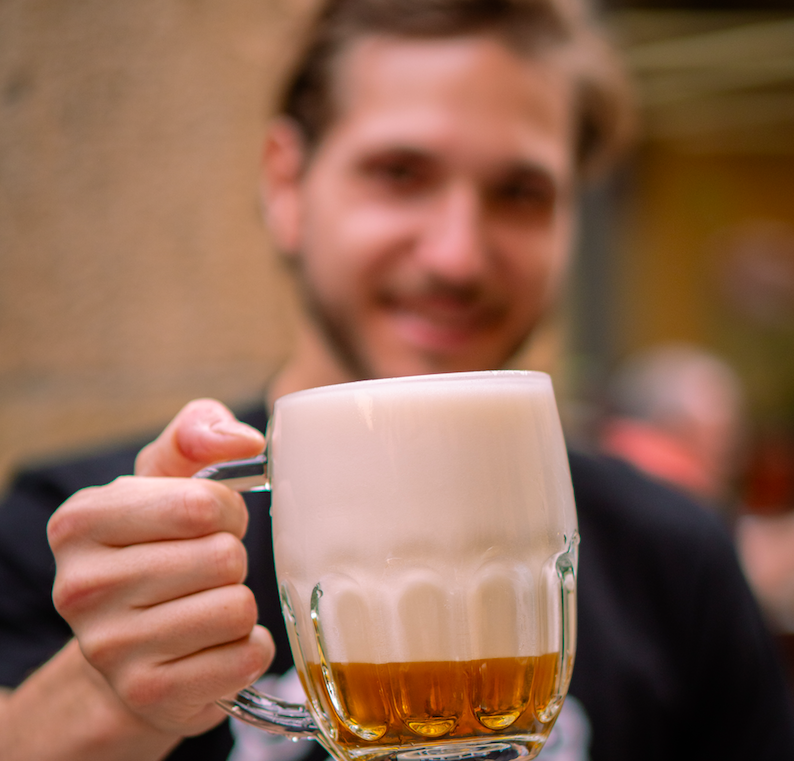When it comes to beer and liquor, Vancouver’s North Shore is turning into a mecca not only here in British Columbia but across the Pacific Northwest. The City of North Vancouver has made the process very streamlined for opening a micro brewery and are encouraging entrepreneurs to come to the brewery district in Lower Lonsdale to setup shop. Adding to the cultural elements of the community while providing much needed jobs for local families.
With that said, we had the distinct pleasure to chat with Brewmaster and Documentary creator Matthew Alexander Kiss aka Mak Kiss, who was one of the original assistant brewers at Green Leaf Brewing and also is in the process of finishing his documentary about how quality water in Iceland makes their local craft beers taste amazing. Mak will be working with us as a blogger and content creator into the future to tell the stories surrounding the local beer and liquor scene near the Lonsdale Avenue corridor. Check out the interview we did with him below.
How did you first get excited about the brewing industry and what is your formal education and experience?
Beer was always something that was a part of my family growing up. Coming from a Danish and Hungarian descent, an imported Danish lager was always present at the lunch smorgasbord. As I became the legal age in British Columbia to drink, my first jobs were at liquor stores, and I was lucky at the time that the Craft Beer scene was just starting to emerge. At the time, Driftwood’s Fat Tug was taking over and all anyone was drinking; it was bold, bitter, and different from everything else. It was at that moment that I realized that beer wasn’t bound by the one-dimensional walls that macro lagers had held in the market for forever.
While I attended university, I started to expand my interest and sought out local breweries that were slowly appearing and started like many did; at the bottom, cleaning tanks and slinging beers in the tap room, slowly working my way up to gain more experience as an assistant brewer.
Originally, I was waiting until I turned 21 to legally be allowed to drink in the States, where I had been looking into a formal education within the brewing industry, because at the time, there wasn’t anything available in Canada. Fortunately for myself, I had found the Niagara Brewmaster and Brewery Operations Management Program, along with its sister program being offered in Alberta. I became part of the 2nd Graduating class in Alberta, and I still attest that what I learned from that program was more in-depth and educational than I would have learned simply by myself at a brewery full time.
The Brewmaster and Brewery Operations Management program was broken down into three core elements: Practical brewing experience through the School’s Brewery, lectures focused on ingredient composition, sensory training, and operations management, as well as biology and chemistry labs focusing on QA/QC sanitary practices and yeast identification and propagation.
After graduating from the program, I decided I wanted to gain international experience within the industry, at which I was lucky enough to quickly take over as the Head Brewer for a craft brewery in New Zealand.
What are your personal favourite types of beer to enjoy in your free time and why?
This question illuminates one of the fallacies of craft beer enthusiasts: we aren’t brand loyal. As fanatics of the beverage, we have an intangible thirst for the next newest creation; seasonal beers containing experimental cross oceanic hop breeds, small batch floor malted smoked grains, a grown in-house gose yeast strain that was swabbed from a local orchard… craft lagers, more craft lagers please.
My favourite response to this question is to say that I have seasonal beer disorder. What time of year is it? When and where am I drinking this beer? Have I just finished a several hour hike in the dead of summer and sitting down for a refreshment? I’ll look for something that’s more sessionable, with a thinner crisp body and refreshing citrus flavour and aromas.
I had the pleasure of attending Oktoberfest in Munich this last year (2019), and I took great enjoyment in the amount of Weissbier I drank around Germany; the distinct flavour of clove, nutmeg and esters along with a fuller body are so strikingly different from the American Wheat Ales that are commonly brewed in Vancouver. If I haven’t had a particular beer style in a while, my first instinct is often to reach for or ask for the different rather than the familiar.
You did a documentary based in Iceland about water quality in the brewing process, can you tell us about that?
Going into filming the documentary, my goal was to focus on the discussion and exploration revolving around each of the 4 main ingredients in beer. I wanted to show the treatment and the implementation of each of these ingredients in the beer industry and their effects on the finished product within your glass.
With beer being about 90% water, one could say that a source of brewing water is one the most important decisions when making a beer. As the first and largest ingredient that goes into the brewing process, water affects every other ingredient and its impact in the beer. John Palmer, who is a slew of information for everything beer, explains this extremely well when he says in an article for Beer & Brewing Magazine:
“Brewing water affects the beer in three ways: it affects the pH of the beer, which affects how the beer flavours are expressed to your palate; it provides ‘seasoning’ from the sulfate-to-chloride ratio; and it can cause off-flavours from chlorine or contaminants.”
John Palmer
To condense down an extreme chemistry lesson of water in beer, water, and the dissolved minerals in the water, affect the pH, mouthfeel, and how other ingredients (malt, hops, and yeast) react in solution. The importance in choosing a water source for brewing is giving the brewer the ability to control all these variables.
To talk about water as a source in the brewing world, I wanted to go where the water was considered to be one of the oldest, freshest sources in the world. In Iceland, the water drawn all comes from thousand year old glaciers and their runoff, often passing through lava fields which would naturally filter through very fine veins. Talking about the water in Iceland though, most people would consider the naturally occurring hot springs caused by the geothermal activity, and its boasted effects for being great for the skin. This water is high in silicates and other minerals such as sulfur, which would be disastrous to brew with.
This fortunately, is only from the hot water found naturally, and not the cold water that is treated in the cities. Of the yearly testing that’s performed in Reykjavik, the most notable test is the level of hardness in the water, which refers to its concentrations of calcium and magnesium. These water samples are measured in units of German hardness (degrees dH). Water that is exceptionally hard will have a number around 30 degrees dH, while water that is exceptionally soft will have a number of zero to four degrees dH. Icelandic water is less than two degrees dH, meaning that it is especially soft. There are even some areas of Reykjavik that the number ranges between 0.2 to 0.6 degrees, being some of the softest water in the world.
One of the reasons that Iceland’s exceptionally soft water is fantastic for brewing is that it starts as a naturally clean slate to build off. From here, brewers can add any mineral salts they feel are necessary for the beer they are brewing as well as the style. Correctly balancing these minerals in the water can go as far as affecting the solubility and isomerization rates of alpha and iso-alpha acids in hops, to the flavour perception of the malts used, and food for yeast.
What do you like most about living and working on Vancouver’s North Shore?
I have left Vancouver, and BC many times for work, school, life and travel; but I keep returning to the North Shore as this is where I was born and raised, and every time I come back, I am reminded of not only the beauty but also what we are blessed to have the privilege of here. Our proximity to nature, being easy access to both the mountains and the beach, as well as the growing craft beer scene over the last several years.
I mentioned above about how Reykjavik had a “blank slate” to brew with, Vancouver has a similar situation to brew with in our water source here; what that means is that the beer coming out of Vancouver can truly be crafted into anything the brewer desires, and I’ve been ecstatic to see more and more breweries opening on the North Shore, where I spend most of my time, and the wide range that I can easily walk to on any given day.
With the (fairly) recent establishment of the Brewery District, and thus the ease for more breweries to open in the area, you see something that doesn’t often happen with competition in other industries, from brewers: an eagerness to collaborate, celebrate and share their craft with each other. The brewing community is one of the friendliest communities I have ever been a part of and encountered. All competition is good competition, driving more customers to their business, and giving options to push each other’s boundaries and collaborate; they are also notorious for sharing recipes and helping each other out where needed, it’s a beautiful thing, and I love to see that being built further on the North Shore.
In your spare time outside of being a blogger and brewmaster what do you get up to for activities?
Suffice it to say that I love beer and talking to people about it. I’m also big on outdoor activities and travel, so for me, the idea to craft a documentary that melded all these interests along with my passion for beer was something that still seems like a dream for me. Education about beer is starting to become more widely spread, which is excellent to see as more people are becoming more informed, and actively seeking out new and different beverages from the macro lagers they may have only ever had in their life.
Beer is brewed and enjoyed in every corner of the globe, and every brewer has their own story to share about their love of the craft, and behind the glass. These are the stories that I want to continue to travel and tell for people, while experiencing the different flavours and styles that come from the different regions in the world.
Is there anything else you might want our readers to know about you?
The documentary we filmed in Iceland is just the first of a pilot I would like to do. As I mentioned above, I would like to do an episodic documentary with a focus on each of the core ingredients, and travel to their international origins to help explore and tell their story. With water and Iceland being the first, once the documentary is completed being edited, I hope to share that to help spread an educational beer show and have the option to film more in the future. As soon as the documentary is available, it will be announced with more information.
If you would like to connect with Mak Kiss use Instagram and you can also email him using matthewalexanderkiss@gmail.com



